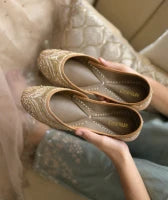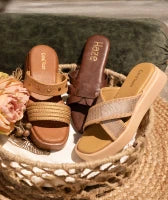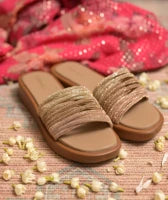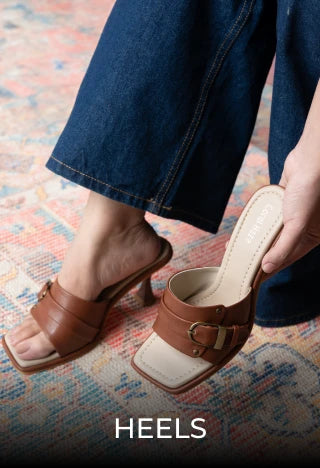
Traditional Indian Juttis: A Blend of Artistry and Culture
Share
Juttis, also known as mojris, are traditional Indian footwear that has captivated the hearts of people for centuries. These exquisitely handcrafted shoes showcase the rich cultural heritage and artistic brilliance of India. From their intricate designs to their comfortable fit, traditional Indian juttis are more than just footwear—they are a testament to the country's diverse traditions and craftsmanship.
History and Origins
The origin of juttis can be traced back to the princely states of Rajasthan and Punjab in India. These regions have a long-standing history of shoemaking, and the craftsmanship has been passed down through generations. Juttis were initially worn by the royals and nobility as a symbol of their status and wealth. Over time, they became popular among people from all walks of life, and today, they are cherished by both men and women across the country.
Design and Artistry
Traditional Indian juttis are renowned for their exquisite design elements and attention to detail. Skilled artisans painstakingly create these shoes using a variety of materials, including leather, silk, velvet, and embroidered fabrics. The designs are often inspired by nature, mythology, and local traditions, making each pair a unique work of art. Intricate hand embroidery, embellishments, and vibrant colors further enhance the beauty of these footwear masterpieces.
Regional Variations
India is a land of diverse cultures, and each region has its own distinctive style of juttis. In Punjab, juttis are known for their vibrant colors, intricate embroidery, and patterns inspired by folk traditions. Rajasthan, on the other hand, boasts juttis adorned with mirror work, beadwork, and colorful threads. Other states like Uttar Pradesh, Gujarat, and Haryana also contribute their unique design aesthetics, making the juttis of each region a reflection of its cultural identity.
Comfort and Durability
Apart from their aesthetic appeal, traditional Indian juttis are cherished for their comfort and durability. Crafted with soft leather and flexible soles, they provide a snug fit and allow the feet to breathe, making them suitable for long hours of wear. The skilled artisans ensure that the shoes are crafted to perfection, ensuring both comfort and longevity.
Modern Trends and Global Appeal
In recent years, traditional Indian juttis have gained popularity worldwide, transcending cultural boundaries. Their unique blend of heritage, craftsmanship, and comfort has made them a sought-after fashion accessory. Renowned fashion designers and celebrities have embraced juttis, incorporating them into their collections and red carpet looks. Today, you can find a wide range of contemporary juttis that blend traditional designs with modern aesthetics, catering to the preferences of a global audience.
Preserving the Legacy
As the world embraces modernity, it is crucial to preserve the legacy of traditional Indian juttis. Artisans and organizations are working tirelessly to promote and sustain this art form. By supporting ethical and sustainable practices, we can ensure the continuity of this cherished tradition and provide livelihoods for skilled craftsmen. Through initiatives such as exhibitions, workshops, and online platforms, traditional Indian juttis continue to thrive, captivating hearts worldwide.
Conclusion
Traditional Indian juttis are more than just footwear; they represent a beautiful tapestry of artistry, culture, and tradition. From their humble origins to their global appeal, these handcrafted shoes have stood the test of time. By embracing and celebrating the beauty of juttis, we contribute to the preservation of India's cultural heritage. So, step into a pair of traditional Indian juttis and experience the elegance and comfort they offer—a perfect fusion of style and tradition.
FAQs (Frequently Asked Questions)
1. Are juttis only worn on special occasions?
No, juttis can be worn on various occasions, ranging from festivals and weddings to casual outings. They are versatile and can be paired with both traditional and contemporary outfits.
2. Are traditional Indian juttis available in different sizes?
Yes, traditional Indian juttis are available in a wide range of sizes to cater to different foot sizes and preferences. It is recommended to refer to the sizing chart or consult with the seller to ensure the perfect fit.
3. Can juttis be worn by both men and women?
Absolutely! Juttis are unisex footwear, and both men and women can enjoy the beauty and comfort of traditional Indian juttis.
4. How do I take care of my juttis?
To maintain the longevity of your juttis, it is recommended to keep them away from moisture, store them in a cool and dry place, and clean them gently with a soft cloth when necessary.
5. Where can I buy traditional Indian juttis?
Traditional Indian juttis can be purchased from reputable online platforms, local artisans, specialized footwear stores, and during cultural festivals and exhibitions. It is advisable to opt for authentic sources to ensure the quality and craftsmanship of the juttis.





